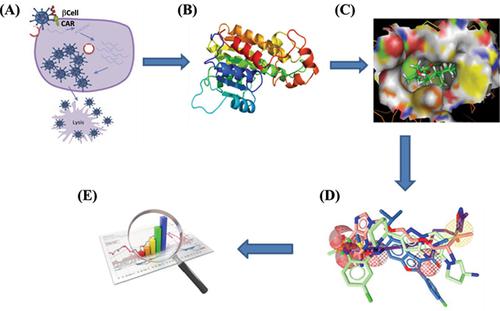Current Computer-Aided Drug Design ( IF 1.5 ) Pub Date : 2020-05-31 , DOI: 10.2174/1573409915666190820154422 Amina Amin 1 , Muhammad A Rasheed 1 , Rana A Diwan 2 , Muhammad Shahid 3 , Saddia Bano 4 , Adnan Riaz 5 , Muhammad N Iqbal 1 , Muhammad W Sajid 1

|
Background: Insulin-dependent Diabetes Mellitus Type 1 (T1D) also referred to as autoimmune diabetes. T1D is a chronic disease which is characterized by way of insulin deficiency. The deficiency is due to the loss of pancreatic β cells and leads to hyperglycemia. There are many factors which play a significant role in T1D disease pathogenicity including genetic predisposition, the immune system, and environmental factors. The environmental factors may include Coxsackie B4 virus, a small RNA virus.
Objective: The objective of current in silico study is to identify active lead compounds against Coxsackie B4 virus, a small RNA virus which has been reported in diabetic patients after PCR. There is a need to predict inhibitors against TID caused by Coxsackie B4 viral protein that may be used as a drug against TID in the future.
Methods: For this purpose, different bioinformatics databases and tools were used. The protein structure generation and validation, retrieval of ligands and their properties analysis were performed by different databases, web servers, and software tools. Moreover, the docking tools were used to identify the target site of the protein and interaction of different inhibitors with the target protein molecule.
Results: Based on the analysis, two lead compounds ZINC00034488 and ZINC00034585 were selected as potential drugs. These compounds are non-toxic and have best interaction energy and fulfill Lipinski rule, Veber rule, Ghose Rule, Weighted QED, Unweighted QED and BBB likeness parameters.
Conclusion: Our work will help researchers to get an idea about the understanding of chemicals against Coxsackie B4 Viruses and helpful to design a drug and test these chemicals to overcome Diabetes Mellitus Type 1 caused by Coxsackie B4 virus.
中文翻译:

抑制2C柯萨奇B病毒蛋白降低1型糖尿病的致病性。
背景:胰岛素依赖型1型糖尿病(T1D)也称为自身免疫性糖尿病。T1D是一种慢性疾病,其特征在于胰岛素缺乏。缺乏是由于胰腺β细胞的损失并导致高血糖症。在T1D疾病的致病性中有许多重要因素,包括遗传易感性,免疫系统和环境因素。环境因素可能包括柯萨奇B4病毒(一种小RNA病毒)。
目的:目前的计算机模拟研究的目的是鉴定针对柯萨奇B4病毒的活性先导化合物,该化合物是一种小RNA病毒,已在糖尿病患者中进行PCR报道。有必要预测由柯萨奇B4病毒蛋白引起的TID抑制剂,该抑制剂将来可能用作TID的药物。
方法:为此,使用了不同的生物信息学数据库和工具。蛋白质结构的生成和验证,配体的检索及其性质分析是通过不同的数据库,Web服务器和软件工具进行的。此外,对接工具用于鉴定蛋白质的靶位点以及不同抑制剂与靶蛋白质分子的相互作用。
结果:在分析的基础上,选择了两种先导化合物ZINC00034488和ZINC00034585作为潜在药物。这些化合物无毒,具有最佳的相互作用能,并满足Lipinski规则,Veber规则,Ghose规则,加权QED,未加权QED和BBB相似性参数。
结论:我们的工作将有助于研究人员了解对柯萨奇B4病毒化学药品的理解,并有助于设计药物和测试这些化学药品以克服由柯萨奇B4病毒引起的1型糖尿病。










































 京公网安备 11010802027423号
京公网安备 11010802027423号